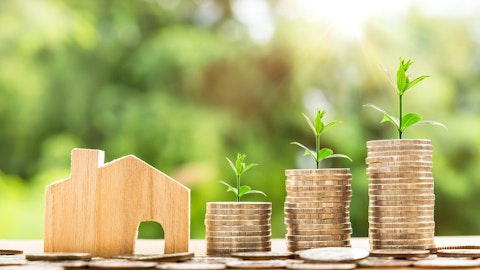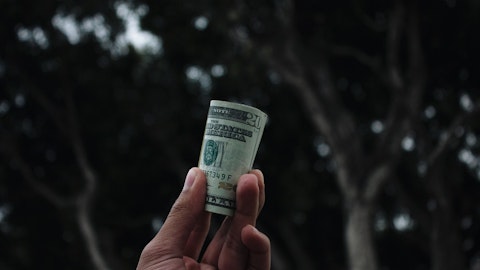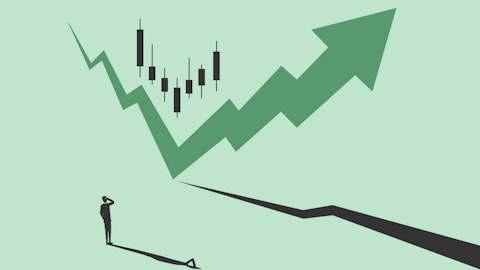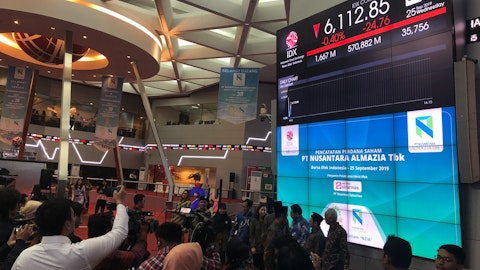Linde plc (NYSE:LIN) Q3 2023 Earnings Call Transcript October 26, 2023
Linde plc beats earnings expectations. Reported EPS is $3.63, expectations were $3.57.
Operator: Ladies and gentlemen, good day, and thank you for standing by. Welcome to Linde’s Third Quarter 2023 Earnings Teleconference and Webcast. At this time, all participants are in a listen-only mode. Please be advised that today’s conference is being recorded. And after the speaker’s presentation, there will be a question-and-answer session. I would now like to hand the conference over to Mr. Juan Pelaez, Head of Investor Relations. Please go ahead, sir.
Juan Pelaez: Thanks, Abbie. And thanks for pronouncing my name correctly. Good morning, everyone, and thank you for attending our 2023 third quarter earnings call and webcast. I am Juan Pelaez, Head of Investor Relations, and I’m joined this morning by Sanjiv Lamba, Chief Executive Officer; and Matt White, Chief Financial Officer. Today’s presentation materials are available on our website at linde.com in the Investors section. Please read the forward-looking statement disclosure on Page 2 of the slides and note that it applies to all statements made during this teleconference. The reconciliations of the adjusted numbers are in the appendix to this presentation. Sanjiv will provide some opening remarks, and then Matt will give an update on Linde’s third quarter financial performance and outlook, after which we will wrap up with Q&A. Let me now turn the call over to Sanjiv.
Sanjiv Lamba: Thank you, Juan, and a very good morning, everyone. Linde employees delivered another solid quarter despite the economic headwinds. Earnings per share grew 17%. Return on capital closed at 25.6%. Operating cash flow was 2.5 billion and operating margins expanded 550 basis points, finishing at 28.3%. And we delivered these results, while continuing to responsibly deploy capital to high-quality growth opportunities and consistent shareholder returns. This is what our owners expect. It’s not new, and not a surprise. Time and again through recessions and global economic shocks, Linde has consistently delivered industry leading results through a relentless productivity culture while increasing network density. And I see no reason why that won’t continue going forward.
In fact, rather than waste time trying to predict what will happen we are constantly striving to perfect a model for all seasons. Here at Linde, we acknowledge the world is a volatile place and as stewards of shareholder capital, we are focused on running an organization which can sustainably deliver on owner expectations. Quality earnings growth, leading return on capital, and strong cash generation are hallmarks of our history and will be integral to our future performance. I think it’s important to remind investors of these key tenets at Linde especially during uncertain times, like today. The combination of inflation, rising interest rates and geopolitical tension is curtailing risk appetite, and hence overall economic activity. However, I remain confident in Linde’s ability to weather any economic downturn based on the strength of our diverse portfolio, and long-term contracts, which is further demonstrated on Slide three.
When you read the news or government statistics, I know it’s hard to be bullish on the global economy. However, when looking at underlying trends by end market, we see a mixed picture with some increasing, while others are flat or slightly down. Overall, underlying sales were up 3% with base volumes, down low single digit percent, which was more than offset by pricing and contribution from project backlog. In other words, the Linde operating model allows us to quickly adapt to maintain steady and compounding value creation, regardless of the macro environment. The resilient consumer related end markets, which represent about 1/3rd of sales of solid growth in food and healthcare, but a mid-single digit percent decrease in electronics. Now, onsite electronic volumes remained stable, with reductions in merchant and package gases, primarily from rare gas sales in Asia.
Based on customer feedback, I believe we will begin seeing signs of recovery in the first half of 2024, due to growing AI demand, and inventory levels stabilizing. Industrial-related markets make up the remaining 2/3rds of sales. And similar to the other sectors, we’re seeing mixed trends here. Manufacturing and chemicals and energy are bolt-up primarily led by the United States. We continue to see U.S. packaged gas volumes stable at a high watermark including met fab as well as the recovery in Gulf Coast hydrogen pipeline volumes, which have carried into the fourth quarter as well. Conversely, metals end market volumes are down slightly from weaker economic conditions. Overall, higher prices and growth from contractual project backlog more than offset weaker base volumes.
This is because our long-term customer contracts, stabilized results through inflation adjustment and fixed payment clauses and differently, we have the right business model and operating rhythm to weather any storm. Looking ahead into the fourth quarter, the U.S. economy continues to navigate at higher levels, with pretty much every end market expected to grow year-on-year and remain stable sequentially. China volumes are expected to remain flattish even as manufacturing, chemicals and energy end markets may show a mild recovery, while still an electronic volumes continue to remain flat. Regarding Europe, we have not yet seen an inflection point. So the expectation is that volumes will hold around the third quarter levels x some normal seasonal impact.
Despite the softer macro environment and higher interest rates, proposal activity continues to be robust, and our backlog has increased by 300 million to 8.1 billion of which 4.5 billion are sale of gas projects. In addition, our clean energy projects continue to progress well as our customers remain committed to decarbonizing their assets. Finally, our priorities remain intact, be best-in-class in safety, compliance, sustainability and talent development while maintaining a high-performance culture, which remains focused on delivering on our commitments. So although the global economy seems tepid, I can only tell you that Linde will continue to deliver on its commitments. I will now turn the call over to Matt to walk you through the financial results.
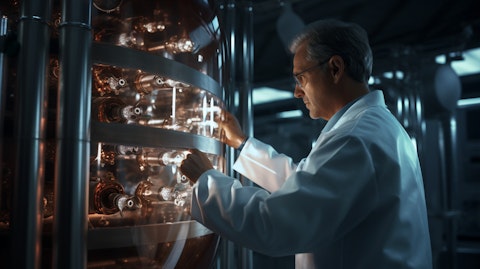
Matt White: Thanks, Sanjiv. Slide 4 provides a summary of third quarter results. Sales of $8.2 billion decreased 7% from last year and 1% sequentially, although these numbers are not indicative of underlying trends. Cost pass-through, which represents the contractual billion of energy cost variances to customers, decreased 6% from last year but had no effect on profit. In addition, the Engineering business decreased 4% from prior year and 1% sequentially due to timing of project billings. When excluding these items, along with impacts from FX and net divestitures, underlying sales increased 3% over last year and 1% over the second quarter. Price increased 5% over prior year and 1% sequentially as the business units continue to contractually recover higher levels of inflation.
In fact, globally weighted CPI for our countries of operation also increased 5% in the third quarter, further validating this correlation. Volumes were flat sequentially and decreased 2% year-over-year, primarily driven by the Electronics and Metals & Mining end markets. Overall, year-to-date volume trends have tracked closely with globally-weighted industrial production. We regularly monitor tank and cylinder returns to validate this correlation and have not identified any material differences. In other words, the volume decline is driven by existing contractual customers requiring less gas refills since their production decreased proportionately with industrial activity in their local economy. I fully expect volumes to recover in line with each local economy.
Operating profit of $2.3 billion increased 15% over prior year and 1% sequentially. Operating margin expanded 550 basis points to 28.3% as price actions, cost productivity, and fixed payment contracts enabled greater leverage from the 3% underlying sales growth. Excluding cost pass-through, operating margins expanded 400 basis points across all business segments, led by EMEA at 600 basis points. Note that America has experienced elevated power cost in the third quarter, which had a negative impact to merchant and packaged margins. However, this will be recovered over the next 1 to 2 quarters. EPS of $3.63 increased 17% as we continue to deliver on the stated goal of double-digit percent EPS growth. CapEx of $950 million increased 24% from last year, primarily due to project CapEx spending in support of the $4.5 billion sale of gas backlog.
As a reminder, the Linde definition of project backlog is unique and the most stringent in the industry. Inclusion requires assured growth, a customer contract with fixed fees and explicit termination provisions to ensure investment returns. Furthermore, the $600 million of base CapEx includes $320 million of additional growth investments to increase network density. During uncertain times like today, shareholders want to sleep well at night knowing their investment is safe in management’s hands, which is further supported on Slide 5. Proper capital management and quality cash generation have always been at the core of our operating rhythm. We’ve been following the same capital allocation policy for decades. It starts with generating true operating cash flow because contrary to what some might think, working capital does matter.
You can see the stable trends, with the most recent quarter coming in at $2.5 billion. Recall that we had some cash tax timing impact in the first half of the year which we’ve now lapped. Therefore, I expect the operating cash flow to EBITDA ratio to remain in the low to mid-80% range. While our mandate is to maintain an A credit rating and grow the dividend, the priority for our capital is to invest into the business. This follows our time-tested investment criteria, which has enabled Linde to consistently achieve industry-leading ROC year-after-year. After investing into the business, surplus cash is used for share repurchases. Having a strong balance sheet, stable cash generation and an active stock repurchase program enables value-creating opportunities during turbulent markets.
In fact, our best stock repurchases happen when equity markets overreact. This is why we recently announced a new $15 billion stock repurchase program, allowing us to optimize our excess free cash flow and robust balance sheet. We’ll continue to take advantage of stock market dislocations and return capital to our owners in a tax-efficient manner. I’ll wrap up with guidance on Slide 6. For the full year, we’re raising guidance to a range of $14 to $14.10, representing a 14% to 15% growth rate. Consistent with prior quarters, the upper end assumes no sequential economic improvement. The updated full year guidance implies a fourth quarter range of $3.38 to $3.48. Excluding FX, the midpoint is down 4% sequentially due to engineering project timing and base volumes, including seasonality, although we are taking actions to improve this range.
As Sanjiv mentioned, global volatility appears to be the norm these days, so we must run our business in a manner which navigates the uncertainty while executing the strategy and delivering on commitments. And while no one can predict what will happen tomorrow, let alone next year, Linde owners can rest assured knowing their capital will be properly managed for sustained compound growth in any environment. I’ll now turn the call over to Q&A.
Operator: Thank you. [Operator Instructions] We will take our first question from Mike Leithead with Barclays. Your line is open.
See also 15 Cheapest Places to Buy a House in California and What are Golden Visas and 10 Countries that Hand Them Out?.
Q&A Session
Follow Lin Media Llc (NYSE:LIN)
Follow Lin Media Llc (NYSE:LIN)
Mike Leithead: Great. Thank you. Good morning. Sanjiv, maybe to start, you talked about some macro crosscurrents impacting risk appetite. And I think there’s probably been a bit of a pullback in the clean energy space, maybe a bit more economic rationality in some green ambitions. So can you speak to beyond what’s already in your backlog, if discussions at all are changing on potential new clean energy products or maybe how is bidding activity today versus maybe earlier this year?
Sanjiv Lamba: Thanks, Mike. And you’re right, there is a bit of a risk off in the market. I have to say that you know our approach to clean energy projects, and at the risk of repeating myself from some previous conversations we’ve had on these calls, we’ve always maintained that technology and scale up resulting in projects that have a competitive position are the ones that are going to move forward. And I want to reiterate today that we are seeing many of those projects that we are currently developing on track for exactly those reasons. We work with Tier 1 customers who have a commitment to decarbonizing but are also looking at cost competitive solutions to do that. So in terms of proposal activity, we’ve gone in the past and had conversations about investment decisions of about $50 billion over a 10-year period.
I’ll say to you that I feel reasonably confident about those numbers. About 60% of that, I see likely happening in the U.S., again, a very strong market where developments continue to be fairly robust. In terms of more near term, in the past, Mike, I’ve said decisions of above anywhere between $9 billion to $10 billion over the next few years. I feel pretty good about that number as well. The projects that we are currently working on and tracking all appear to be on that path. And most recently, you would have heard in Dow’s earnings call a couple of days ago, Jim outlining the fact that their project in Alberta is moving to FID towards the end of the year. Again, that’s just a validation of the outlook that I’ve given you. One last comment.
You heard me be skeptical around developments in green. And I’ve said in the past a number of times, there are a few factors that impact us. One, investment renewable energy to make sure there is enough renewable energy available for electrolyzers to produce green hydrogen. In this environment, that continues to be a challenge. Obviously, technology and scale up on green is also lacking today. I’ve said in the past and I maintained that’s probably 5 to 7 years away, and I expect those developments to feed out as we see that point of inflection, maybe a decade from now when green energy projects really are available at scale at a cost-competitive level and meaningfully to be deployed in the energy transition.
Operator: We will take our next question from Laurent Favre with BNP. Your line is open.
Laurent Favre: Yes. Good morning, all. I got a question on China. Sanjiv, you talked about flattish volumes. I was wondering if this is a comment about the near term? Or also if that’s how you feel about the medium term and are you adjusting resources and productivity at all?
Sanjiv Lamba: Laurent, that’s a good question. Why don’t I just kind of give you a feel for what I think is happening in China as we see it today, and then we’ll talk a little bit about the medium term as well. So in the near term, one of the good things in China, which is on a slow road to recovery I say to you is that we supply Tier 1 customers that are the most competitive in their field and have been quite stable through this downturn. Now, let me give you kind of a little bit more color on some of the end markets that we’re seeing over there. I’ll start with chemicals to begin with. Sequentially, we saw a bit of softness, but year-on-year chemical production was actually pretty much flat. For Q4, which is more near term, we’re expecting potentially a mild recovery as a result of a bit more cautious view on domestic consumption and weak external environment.
